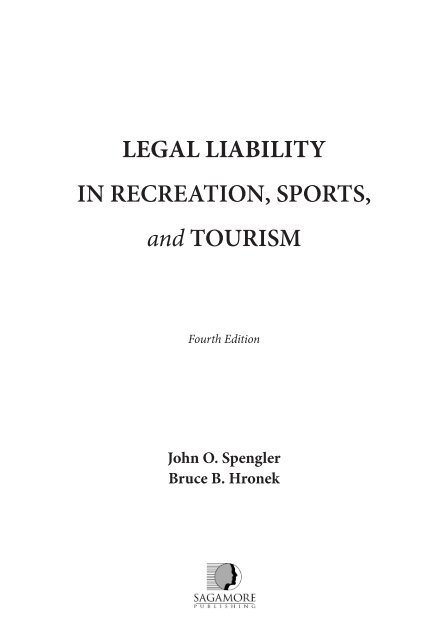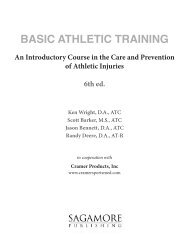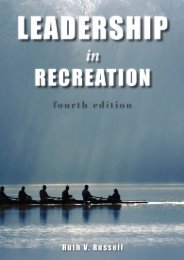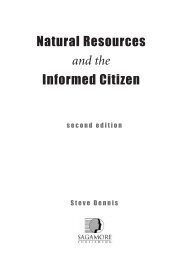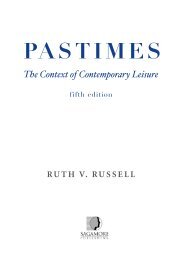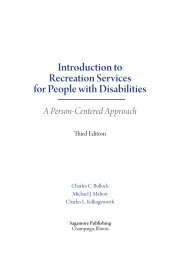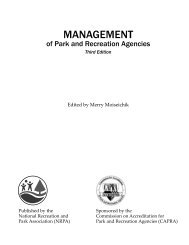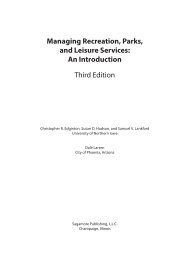Legal Liability in Recreation, Sports, and Tourism - Sagamore ...
Legal Liability in Recreation, Sports, and Tourism - Sagamore ...
Legal Liability in Recreation, Sports, and Tourism - Sagamore ...
Create successful ePaper yourself
Turn your PDF publications into a flip-book with our unique Google optimized e-Paper software.
LEGAL LIABILITY<br />
IN RECREATION, SPORTS,<br />
<strong>and</strong> TOURISM<br />
Fourth Edition<br />
John O. Spengler<br />
Bruce B. Hronek
@2011 John O. Spengler <strong>and</strong> Bruce B. Hronek<br />
Publishers: Joseph J. Bannon <strong>and</strong> Peter L. Bannon<br />
Director of Sales <strong>and</strong> Market<strong>in</strong>g: M. Douglas S<strong>and</strong>ers<br />
Director of Development <strong>and</strong> Production: Susan M. Davis<br />
Director of Technology: Chris Thompson<br />
ISBN pr<strong>in</strong>t edition: 978-1-57167-643-6<br />
ISBN ebook: 978-1-57167-644-3<br />
LCCN: 2011936032<br />
10 9 8 7 6 5 4 3 2 1<br />
<strong>Sagamore</strong> Publish<strong>in</strong>g, LLC<br />
1807 N. Federal Dr.<br />
Urbana, IL 61801<br />
www.sagamorepub.com
For Carol<strong>in</strong>e <strong>and</strong> Matthew<br />
For Sylvia
Contents<br />
Acknowledgments.................................................................................................................... ix .<br />
Foreword.................................................................................................................................. x .i<br />
Introduction.............................................................................................................................. x .iii<br />
PART 1: FOUNDATION.......................................................................................................... 1<br />
Chapter 1<br />
Section 1<br />
Section 2<br />
Section 3<br />
Section 4<br />
Chapter 2<br />
Section 1<br />
Section 2<br />
Introduction to <strong>Recreation</strong> <strong>Legal</strong> Issues..................................................................3<br />
Trends.............................................................................................................................3<br />
Categories of <strong>Legal</strong> <strong>Liability</strong>........................................................................................7<br />
International Issues......................................................................................................9<br />
<strong>Legal</strong> Research.............................................................................................................15<br />
Introduction to the <strong>Legal</strong> Process...........................................................................19<br />
The Judicial System.....................................................................................................19<br />
Civil Procedure...........................................................................................................22<br />
PART 2: NEGLIGENCE..........................................................................................................31<br />
Chapter 3 The Negligence Cause of Action............................................................................. 33<br />
Chapter 4 Strict <strong>Liability</strong>............................................................................................................ 41<br />
Chapter 5 <strong>Legal</strong> Protections...................................................................................................... 49<br />
Section 1 Defenses to Negligence............................................................................................. 49<br />
Section 2 Contractual Protections (Waivers).......................................................................... 63<br />
Section 3 The Agreement to Participate.................................................................................. 70<br />
PART 3: INTENTIONAL TORTS.........................................................................................75<br />
Introduction ...........................................................................................................................76<br />
Chapter 6 Harm to Persons....................................................................................................... 79<br />
Chapter 7 Trespass...................................................................................................................... 89<br />
Section 1 Trespass to L<strong>and</strong>........................................................................................................89<br />
Section 2 Trespass to Chattel <strong>and</strong> Conversion........................................................................94<br />
Chapter 8<br />
Defenses to Intentional Torts.................................................................................99<br />
PART 4: CONSTITUTIONAL RIGHTS............................................................................109<br />
Chapter 9<br />
Chapter 10<br />
Section 1<br />
Section 2<br />
Section 3<br />
Chapter 11<br />
Human Rights <strong>Liability</strong>........................................................................................111<br />
Due Process, Privacy, Speech, <strong>and</strong> Religion.....................................................119<br />
Due Process (14th Amendment)..........................................................................119<br />
Privacy......................................................................................................................122<br />
Speech <strong>and</strong> Religion................................................................................................126<br />
Discrim<strong>in</strong>ation.............................................................................................137<br />
v
PART 5: RISK ASSESSMENT IN RECREATION, SPORTS, AND TOURISM........147<br />
Chapter 12 The Risk Management Process............................................................................ 149<br />
Chapter 13 Risk Assessment Overview................................................................................... 155<br />
Section 1 Considerations......................................................................................................... 156<br />
Chapter 14 Approaches to Risk Assessment.......................................................................... 167<br />
Chapter 15 Insurance................................................................................................................. 175<br />
PART 6: WORKPLACE RISK.............................................................................................183<br />
Chapter 16 Employee Term<strong>in</strong>ation......................................................................................... 185<br />
Chapter 17 Sexual Harassment <strong>in</strong> the Workplace................................................................ 191<br />
Chapter 18 Employee Safety <strong>and</strong> Health................................................................................ 201<br />
Chapter 19 The Americans with Disabilities Act.................................................................. 205<br />
Chapter 20 Employee Evaluations........................................................................................... 215<br />
PART 7: OUTDOOR RECREATION MANAGEMENT.............................................. 221<br />
Introduction..........................................................................................................................................223<br />
Chapter 21<br />
Section 1<br />
Section 2<br />
Section 3<br />
Section 4<br />
Chapter 22<br />
Section 1<br />
Section 2<br />
Chapter 23<br />
St<strong>and</strong>ard of Care for Park Managers..................................................................225<br />
Natural Feature Hazards........................................................................................226<br />
Weather Hazards....................................................................................................237<br />
Classification of Users............................................................................................244<br />
Concessionaires, Leases, <strong>and</strong> Contracts..............................................................249<br />
Adventure/Challenge <strong>Recreation</strong>.......................................................................255<br />
High-Risk <strong>Recreation</strong>............................................................................................255<br />
Challenge Activities...............................................................................................262<br />
Protection Issues....................................................................................................267<br />
PART 8: MANAGING SPORTS AND RECREATIONAL ACTIVITIES.................... 273<br />
Introduction ..................................................................................................................................275<br />
Chapter 24<br />
Section 1<br />
Section 2<br />
Section 3<br />
Chapter 25<br />
Section 1<br />
Section 2<br />
Section 3<br />
The Responsible Leader....................................................................................277<br />
Supervision..............................................................................................................277<br />
Instruction...............................................................................................................287<br />
Emergency Medical Care......................................................................................290<br />
Facilities <strong>and</strong> Equipment.................................................................................297<br />
Facilities...................................................................................................................297<br />
Equipment...............................................................................................................304<br />
Security Issues <strong>in</strong> <strong>Recreation</strong>, <strong>Sports</strong>, <strong>and</strong> <strong>Tourism</strong>...........................................310<br />
Chapter 26 Warn<strong>in</strong>gs...................................................................................................... 315<br />
vi
Chapter 27 Playgrounds................................................................................................... 327<br />
Section 1 St<strong>and</strong>ard of Care.......................................................................................................328<br />
Section 2 Playground Surfaces.................................................................................................330<br />
Section 3 The Playground Safety Audit...................................................................................332<br />
Chapter 28 Aquatics......................................................................................................... 339<br />
Section 1 St<strong>and</strong>ard of Care.......................................................................................................340<br />
Section 2 Duty to Supervise the Activity—Lifeguards..........................................................341<br />
Section 3 Duty to Provide Safe Premises................................................................................349<br />
Section 4 Duty to Provide Safe Equipment............................................................................354<br />
About the Authors.................................................................................................................................358<br />
Index.......................................................................................................................................................359<br />
vii
Acknowledgments<br />
The authors wish to thank all those who sacrificed their time <strong>and</strong> energy to make<br />
this book possible—family, friends, colleagues, <strong>and</strong> associates. Thanks go to Daniel<br />
Castellano <strong>and</strong> Gordon Wilson, who helped with updat<strong>in</strong>g <strong>and</strong> shepherd<strong>in</strong>g the cases<br />
<strong>in</strong> this new edition.<br />
ix
Foreword<br />
We practice our professional recreation, sport, <strong>and</strong> tourism management skills <strong>in</strong> a<br />
different world than we experienced a few decades ago. There is a propensity for people<br />
to sue if they are <strong>in</strong>jured or receive property damage. Extensive litigation has resulted <strong>in</strong><br />
significantly <strong>in</strong>creased <strong>in</strong>surance rates while organizations <strong>and</strong> agencies are becom<strong>in</strong>g<br />
<strong>in</strong>creas<strong>in</strong>gly unwill<strong>in</strong>g to provide some high-risk recreation <strong>and</strong> tourism services that<br />
they provided <strong>in</strong> the past.<br />
<strong>Recreation</strong>, sports, <strong>and</strong> tourism activities conta<strong>in</strong> all the elements necessary to<br />
make those activities subject to accidents <strong>and</strong> subsequent lawsuits. <strong>Sports</strong> <strong>and</strong> recreation<br />
activities generally are competitive, fast-paced, use equipment <strong>and</strong> facilities, <strong>and</strong><br />
<strong>in</strong>clude physical <strong>and</strong>/or social contact. <strong>Tourism</strong> places people <strong>in</strong> unfamiliar locations<br />
with vary<strong>in</strong>g safety st<strong>and</strong>ards.<br />
When these elements are comb<strong>in</strong>ed, they can result <strong>in</strong> accidents. This text provides<br />
guidance for students to study risk management pr<strong>in</strong>ciples that will <strong>in</strong>crease their<br />
management skills. The book provides practitioners the underst<strong>and</strong><strong>in</strong>g necessary to<br />
manage the activities <strong>in</strong> such a manner that it will m<strong>in</strong>imize the potential of a successful<br />
pla<strong>in</strong>tiff suit.<br />
This book provides a legal structure by which students can best learn liability <strong>and</strong><br />
risk management pr<strong>in</strong>ciples, <strong>and</strong> professionals can protect themselves <strong>and</strong> their organizations<br />
from those seek<strong>in</strong>g to take advantage of the judicial system for personal ga<strong>in</strong>.<br />
In order for recreation, sports <strong>and</strong> tourism managers <strong>and</strong> practitioners to be successful<br />
<strong>in</strong> prevent<strong>in</strong>g accidents <strong>and</strong> litigat<strong>in</strong>g issues, they must have knowledge of risk management<br />
<strong>and</strong> legal pr<strong>in</strong>ciples.<br />
The authors, John Spengler <strong>and</strong> Bruce Hronek, not only have a rich legal background,<br />
but also have practical on-the-ground experience that provide a no-nonsense<br />
approach to the problems associated with legal liability <strong>in</strong> recreation <strong>and</strong> sports. They<br />
are practitioners, teachers, <strong>and</strong> researchers <strong>in</strong> the field of risk management <strong>and</strong> legal<br />
liability.<br />
Tony Mobley, Dean Emeritus<br />
School of Health, Physical Education, <strong>and</strong> <strong>Recreation</strong> (HPER)<br />
Indiana University<br />
xi
Efforts have been made to make this book as accurate as possible. This book<br />
covers many general facets of legal liability. In order to give the readers a general<br />
underst<strong>and</strong><strong>in</strong>g of the law, the book does not <strong>in</strong>clude all aspects of each legal situation.<br />
There are differences <strong>in</strong> the law <strong>in</strong> various jurisdictions, <strong>and</strong> there are legal<br />
nuances <strong>and</strong> differ<strong>in</strong>g <strong>in</strong>terpretations of the law by <strong>in</strong>dividuals <strong>and</strong> organizations.<br />
Application of the pr<strong>in</strong>ciples <strong>and</strong> statements made <strong>in</strong> this book may be not be applicable<br />
<strong>in</strong> all circumstances <strong>and</strong> jurisdictions.<br />
This book is not <strong>in</strong>tended as a substitute for legal counsel. Readers should<br />
consult with legal counsel whenever a legal question occurs.<br />
xii
Introduction<br />
The subject of legal liability conjures up thoughts of high costs, fiscal devastation,<br />
difficult legal language, attorneys, myriad legal papers, <strong>and</strong> time-consum<strong>in</strong>g<br />
litigation. People generally fear those th<strong>in</strong>gs that they don’t underst<strong>and</strong>. The major<br />
purpose of this book is to provide recreation <strong>and</strong> sports students, practitioners, <strong>and</strong><br />
professionals <strong>in</strong> the field with a body of knowledge that will help them manage the<br />
legal risks that are an everyday part of their lives.<br />
In the past, the field of recreation appeared to be sacrosanct when it came to<br />
people want<strong>in</strong>g to sue for damages. Prior to 50 years ago, when lawsuits were filed,<br />
the courts considered leisure pursuits as frivolous, <strong>and</strong> therefore counter to the<br />
good of society. The social structure <strong>and</strong> so-called “Protestant ethic” of the time<br />
called for hard work, not recreation. Only the very rich were privileged to have<br />
“leisure time.” In the past decades, the average citizen’s opportunity for leisure has<br />
<strong>in</strong>creased significantly, <strong>and</strong> so has the extent of recreation, sport, <strong>and</strong> tourism litigation.<br />
Times have <strong>in</strong>deed changed!<br />
There was a time when su<strong>in</strong>g someone was not so common <strong>in</strong> the field of recreation,<br />
sports, <strong>and</strong> tourism. A young forester, graduat<strong>in</strong>g with a degree <strong>in</strong> forestry,<br />
reported to his first professional assignment with the U.S. Forest Service. His<br />
professional career started <strong>in</strong> the back country of the Salmon River <strong>in</strong> Idaho. The<br />
mounta<strong>in</strong>s of central Idaho were beautiful, the air was clean, <strong>and</strong> the work was<br />
<strong>in</strong>terest<strong>in</strong>g <strong>and</strong> challeng<strong>in</strong>g. There was little else that a young professional forester<br />
needed or wanted.<br />
Early one even<strong>in</strong>g a few weeks after he had reported to work, he heard a knock<br />
on his cab<strong>in</strong> door <strong>and</strong> a rather excited man reported that a woman was “<strong>in</strong> trouble”<br />
at a nearby campground. The man said the woman had entered the campground<br />
restroom (a polite name for an old-fashioned smelly s<strong>in</strong>gle-seat outhouse) <strong>and</strong> had<br />
fallen through the floor <strong>in</strong>to the pit that had been dug beneath the toilet to hold<br />
the refuse. The young forester hurriedly loaded the pickup with what turned out to<br />
be mostly useless equipment <strong>and</strong> rushed to the rescue. The site where the accident<br />
occurred was an old campground that had been built by the Civilian Conservation<br />
Corps <strong>in</strong> the mid-1930s.<br />
Upon arrival at the scene of the accident, he found a large woman <strong>in</strong> the toilet<br />
pit with only her head above ground level. She was unable to extract herself from<br />
the hole, even with people try<strong>in</strong>g to lift her out. The old floorboards <strong>and</strong> cross supports<br />
had been weakened by wood rot, <strong>and</strong> the floor collapsed under the woman’s<br />
250-plus pound weight.<br />
The small group of people appeared to be relieved when “the forest ranger” arrived.<br />
Unknown to the campers, he did not have the fa<strong>in</strong>test notion as to what to<br />
xiii
do. The toilet was built <strong>and</strong> used <strong>in</strong> an era when deep holes were dug to hold the waste.<br />
Whenever the pit was full of waste it was covered with dirt, <strong>and</strong> another pit was dug.<br />
The toilet build<strong>in</strong>g was then skidded to the new location. Pits were sanitized by ma<strong>in</strong>tenance<br />
crews us<strong>in</strong>g large amounts of highly caustic white powdered lye. The lye did little<br />
to reduce the unpleasant odor, but it was used anyway for “sanitation purposes.”<br />
The caustic lye burned the sk<strong>in</strong> of the unfortunate woman. She had abrasions <strong>and</strong><br />
was <strong>in</strong> pa<strong>in</strong> from the downward plunge <strong>and</strong> was very embarrassed by her predicament.<br />
The women graciously awaited her rescue without a compla<strong>in</strong>t.<br />
With the help of some of the people <strong>in</strong> the campground, the toilet build<strong>in</strong>g was<br />
sawed down <strong>and</strong> removed us<strong>in</strong>g a deafen<strong>in</strong>g power saw that also covered the woman<br />
with sawdust <strong>and</strong> debris. The rescuers then rigged an “A” frame, <strong>and</strong> a block, <strong>and</strong> a<br />
tackle over the pit. After she was wrapped <strong>in</strong> rope, the rescuers slowly lifted her out of<br />
the pit.<br />
She apologized for all the problems she had caused <strong>and</strong> walked down to the river<br />
to clean up after her ordeal. That was the last time the young forester saw or heard from<br />
the woman. The possibility of a suit or damage claim was never mentioned nor was a<br />
suit ever filed. The year was 1959.<br />
A serious review of what is now a rather humorous occurrence could result <strong>in</strong><br />
sleepless nights if it occurred today. An accident of this type today would be highly<br />
likely to result <strong>in</strong> a negligence suit with a potentially substantial court award. Attitudes<br />
<strong>and</strong> the propensity to sue have changed.<br />
The fear of be<strong>in</strong>g sued is an ever-present part of American society. A number of<br />
years ago, many of these cases would have been considered m<strong>in</strong>or <strong>in</strong>cidents or accidents,<br />
<strong>and</strong> su<strong>in</strong>g would not have been a solution. Today, however, people appear not to<br />
want to accept the normal dynamics of liv<strong>in</strong>g <strong>in</strong> a world of bumps <strong>and</strong> mishaps.<br />
In the 19th century <strong>and</strong> <strong>in</strong>to the 20th century, the courts tried very few cases <strong>in</strong>volv<strong>in</strong>g<br />
recreation, sports, <strong>and</strong> tourism. Our culture, especially s<strong>in</strong>ce World War II, has<br />
gradually evolved <strong>in</strong>to a very litigious society. Many, if not most people, feel that someone<br />
owes them someth<strong>in</strong>g if they are <strong>in</strong>jured or have lost property.<br />
Highway billboards, the yellow pages, <strong>and</strong> newspaper ads encourage <strong>and</strong> entice<br />
people to file suit by advertis<strong>in</strong>g legal services with bold headl<strong>in</strong>es that generally state:<br />
“INJURED” followed by statements such as, “IT COSTS YOU NOTHING TO TALK<br />
TO US. WE ARE PAID ONLY IF YOU COLLECT.” These are tempt<strong>in</strong>g statements for<br />
someone who has mount<strong>in</strong>g medical bills or is angry about an accident or property<br />
loss.<br />
On the other side of the issue of excessive litigation, it should be noted that not all<br />
negligence suits are frivolous. The civil courts serve an important service to our society<br />
<strong>in</strong> provid<strong>in</strong>g all citizens a means by which disagreements can be settled <strong>and</strong> wrongs<br />
righted without personal revenge <strong>and</strong> physical violence. The access to civil courts by an<br />
average citizen can right a wrong committed by the largest <strong>and</strong> most powerful <strong>in</strong>stitutions,<br />
organizations, <strong>and</strong> <strong>in</strong>dividuals. This right to litigate must always be protected <strong>and</strong><br />
made available to our citizens as part of our democratic form of government.<br />
Because many accidents result from un<strong>in</strong>tentional, but nevertheless negligent <strong>and</strong><br />
thoughtless acts, a wise <strong>and</strong> prudent organization or <strong>in</strong>dividual should try to settle<br />
xiv
justifiable legal claims for compensation out of court. Suits should be the last resort for<br />
claims <strong>and</strong> disagreements.<br />
This book was developed to help posture <strong>in</strong>dividuals <strong>and</strong> organizations to prevent<br />
<br />
accidents <strong>and</strong> property loss <strong>and</strong> to counteract excessive legal claims. It is written <strong>in</strong> an<br />
<br />
<strong>in</strong>formal manner to enhance the learn<strong>in</strong>g process <strong>and</strong> particularly to facilitate the underst<strong>and</strong><strong>in</strong>g<br />
of a rather complex body of law. General areas of<br />
<br />
law<br />
<br />
discussed<br />
<br />
<strong>in</strong> the<br />
<br />
text<br />
<br />
<strong>in</strong>clude a legal foundation, negligence, <strong>in</strong>tentional torts, constitutional law, personnel <br />
risk, recreation <strong>and</strong> event management, recreational sports, <br />
playgrounds, <strong>and</strong> aquatics<br />
liability, as well as other subject areas related to recreation <strong>and</strong> sports legal liability. The <br />
authors believe that knowledge of legal liability subject areas <br />
is critical to implement<strong>in</strong>g<br />
a good risk management program. This book focuses on identification <br />
of legal risks,<br />
evaluation of the risks, <strong>and</strong> the implementation of an action <br />
plan to manage the risks.<br />
This book is not a substitute for good legal counsel. While <br />
the book will cover<br />
many general facets of liability, the law may vary among <br />
the various jurisdictions.<br />
Readers should consult with legal counsel whenever a legal <br />
question occurs.<br />
All recreation, sports, <strong>and</strong> tourism activities have some<br />
<br />
degree of risk. <strong>Legal</strong> liability<br />
related to parks, events, <strong>and</strong> recreational sports<br />
<br />
come <strong>in</strong> many forms <strong>and</strong> statistical probabilities. <strong>Legal</strong><br />
liability is most obvious <strong>in</strong> terms of physical risk (accidents<br />
<strong>and</strong> <strong>in</strong>juries), f<strong>in</strong>ancial risk (loss of property <strong>and</strong><br />
<br />
potential <strong>in</strong>come), psychological risk (mental health<br />
<br />
<strong>and</strong> personal well-be<strong>in</strong>g), <strong>and</strong> political risk (public<br />
<br />
support <strong>and</strong> f<strong>in</strong>anc<strong>in</strong>g).<br />
<br />
When many <strong>in</strong>dividuals th<strong>in</strong>k about their personal<br />
<br />
experiences with recreation <strong>and</strong> sports, they soon conclude<br />
that many of their most memorable recreation<br />
<br />
<br />
experiences <strong>in</strong>cluded a strong element of personal risk.<br />
<br />
Activities such as river runn<strong>in</strong>g, mounta<strong>in</strong> climb<strong>in</strong>g,<br />
<br />
wilderness use, hik<strong>in</strong>g, bicycl<strong>in</strong>g, football, skydiv<strong>in</strong>g,<br />
<br />
baseball, ecotourism, driv<strong>in</strong>g for pleasure, <strong>and</strong> wildlife <br />
Kayak<strong>in</strong>g is a popular<br />
watch<strong>in</strong>g are very popular activities with <strong>in</strong>creas<strong>in</strong>g <br />
recreational activity that<br />
numbers of participants. And they all conta<strong>in</strong> a relatively<br />
high level of risk. Increas<strong>in</strong>g numbers of people<br />
<br />
<br />
conta<strong>in</strong>s an element of risk.<br />
<br />
participate <strong>in</strong> high-risk activities because they consider the risks<br />
<br />
to be manageable.<br />
Implement<strong>in</strong>g risk management plans make all recreation, <br />
sports, <strong>and</strong> tourism<br />
activities manageable <strong>and</strong> more enjoyable, but some element of risk <br />
will always be present<br />
<strong>in</strong> any activity. Even a child’s sw<strong>in</strong>g <strong>in</strong> a park has some of the factors conducive <br />
to an accident: immature physical coord<strong>in</strong>ation, speed, <strong>and</strong> height. Risk management <br />
reduces the potential of accidents <strong>and</strong> lawsuits but it does not <br />
elim<strong>in</strong>ate the possibility.<br />
<strong>Recreation</strong>, sports, <strong>and</strong> tourism observers might conclude that <br />
activities without some<br />
level of risk are dull <strong>and</strong> lack excitement. Tak<strong>in</strong>g the risk out <br />
of life is tantamount to tak<strong>in</strong>g<br />
the pleasure out of life.<br />
<br />
The question of whether to warn people of a hidden danger is both legal <strong>and</strong> ethical<br />
<strong>in</strong> nature. It is very true that you cannot warn people about every conceivable risk. Some<br />
legal counsel may believe <strong>in</strong>dividuals <strong>and</strong> organizations should not <strong>in</strong>form people of a<br />
xv
danger that is not obvious. For example, there is an ethical <strong>and</strong> legal dilemma associated<br />
with warn<strong>in</strong>g people that there is “th<strong>in</strong> ice” on a lake. If the danger is known <strong>and</strong><br />
you do noth<strong>in</strong>g about it, there is an element of foreseeable danger <strong>and</strong> negligence if an<br />
accident occurs. The quick answer to the problem may be protective fenc<strong>in</strong>g of the area.<br />
However, the reality of fenc<strong>in</strong>g an entire lakeshore is likely to be an economic impossibility.<br />
The post<strong>in</strong>g of “Danger—Th<strong>in</strong> Ice” warn<strong>in</strong>g signs may be another alternative.<br />
However, this type of sign does not adequately warn the very young, those who do not<br />
read, or those who do not read English. “How far do I need to go” <strong>and</strong> “What should<br />
I do to keep people safe” will always be ethical <strong>and</strong> legal questions for a risk manager.<br />
The courts will decide whether you went far enough. It may be wise to personalize a<br />
risk decision by ask<strong>in</strong>g the question, “If my family were visit<strong>in</strong>g the area or engaged <strong>in</strong> the<br />
activity, what warn<strong>in</strong>g of danger would I want them to have <strong>in</strong> my absence”<br />
Hav<strong>in</strong>g a policy of warn<strong>in</strong>g people about all hazards is neither wise nor possible.<br />
The reason it is not wise is somewhat subtle; when the average person sees a large number<br />
of warn<strong>in</strong>g notices <strong>and</strong> signs, dangers lose their significance <strong>in</strong> the long list<strong>in</strong>gs <strong>and</strong><br />
mere volume of <strong>in</strong>formation. Behavioral scientists <strong>in</strong>dicate that more than five <strong>in</strong>formation<br />
<strong>and</strong> warn<strong>in</strong>g signs <strong>in</strong> the same location tend to be ignored.<br />
Some managers want to sign the obvious. With<strong>in</strong> a recreation site, one can f<strong>in</strong>d<br />
signs <strong>and</strong> brochures stat<strong>in</strong>g “no litter<strong>in</strong>g,” “stay on path,” <strong>and</strong> other warn<strong>in</strong>gs that<br />
should be assumed by the visitor <strong>in</strong> that sett<strong>in</strong>g. Signs <strong>and</strong> pr<strong>in</strong>ted materials <strong>in</strong>form<strong>in</strong>g<br />
or warn<strong>in</strong>g about items <strong>and</strong> hazards that are not obvious may be most useful to the participants<br />
<strong>and</strong> visitors. Signs that <strong>in</strong>form visitors <strong>and</strong> participants about hidden hazards,<br />
fire regulations, <strong>and</strong> rules are also helpful <strong>and</strong> useful for a good recreational experience.<br />
When a risk management program is focused on serv<strong>in</strong>g the public <strong>in</strong>terest, then it<br />
will likely be ethical <strong>and</strong> effective. Judges <strong>and</strong> juries recognize programs that are aimed<br />
at provid<strong>in</strong>g a safe program for the visitors <strong>and</strong> participants. When accidents do occur,<br />
they are more defendable <strong>in</strong> a court of law. The risk management focus should always<br />
be visitor- <strong>and</strong> employee-oriented.<br />
When risk management programs are defensive <strong>in</strong> nature, they lose creativity <strong>and</strong><br />
broad support. A good safety <strong>and</strong> risk management program focused on the visitor or<br />
participant is good public policy.<br />
All employees <strong>in</strong> an effective risk management-oriented organization must have<br />
a common risk management attitude. There are many organizations that designate<br />
specific positions with<strong>in</strong> their organizations as “Safety Officers” or “Risk-Management<br />
Directors.” While it is good to have someone to track safety records or follow up on<br />
complex Occupational Safety <strong>and</strong> Health Act (OSHA) requirements, the designation<br />
of a safety officer or risk manager might have the un<strong>in</strong>tended consequence of mak<strong>in</strong>g<br />
employees feel that someone other than themselves is responsible for safety with<strong>in</strong> their<br />
work environment. Every <strong>in</strong>dividual <strong>in</strong> an organization, from the president or CEO to<br />
the custodian or clerk, should feel a strong obligation to identify <strong>and</strong> take actions to<br />
reduce potential risks. Every member of an organization should be a risk manager or<br />
safety officer. Effective risk management requires that all employees be empowered to<br />
take actions to prevent accidents from occurr<strong>in</strong>g.<br />
xvi
Part One<br />
FOUNDATION
Chapter One<br />
INTRODUCTION TO<br />
RECREATION LEGAL ISSUES<br />
SECTION 1: TRENDS<br />
Professional managers need to know what is happen<strong>in</strong>g around them<br />
<strong>in</strong> regards to trends, risk, <strong>and</strong> legal liability. It is difficult to keep current <strong>in</strong><br />
a field that changes with new legislation, precedent-sett<strong>in</strong>g court cases, the<br />
<strong>in</strong>troduction of new products, <strong>and</strong> the development of new recreational activities.<br />
The emergence of new outdoor recreation activities has resulted <strong>in</strong><br />
significant risk management concerns <strong>and</strong> management adjustments. With<strong>in</strong><br />
the last 25 years, we have seen the appearance of recreation activities that<br />
<strong>in</strong>clude <strong>in</strong>l<strong>in</strong>e skat<strong>in</strong>g, hang glid<strong>in</strong>g, skateboard<strong>in</strong>g, w<strong>in</strong>d sail<strong>in</strong>g (w<strong>in</strong>d surf<strong>in</strong>g),<br />
snowboard<strong>in</strong>g, geocach<strong>in</strong>g, mounta<strong>in</strong> bik<strong>in</strong>g, <strong>and</strong> the re-emergence<br />
of orienteer<strong>in</strong>g, to name a few. Equipment development, such as GPS, has<br />
allowed people to access areas that most would not have ventured <strong>in</strong>to a decade<br />
ago. Each activity has brought about new concerns related to risk <strong>and</strong><br />
participant safety. There is reason to believe that new activities <strong>and</strong> products<br />
will be developed requir<strong>in</strong>g prompt responses from professional managers.<br />
Risk management was born of necessity—human, legal, <strong>and</strong> political.<br />
As early as the late 1800s, the American Labor movement, particularly the<br />
coal m<strong>in</strong><strong>in</strong>g unions, saw their union m<strong>in</strong>ers endangered by careless m<strong>in</strong><strong>in</strong>g<br />
practices. Underground explosions, collapsed m<strong>in</strong>es, toxic gasses, <strong>and</strong> black<br />
lung disease were common <strong>and</strong> considered simply a fact of life <strong>in</strong> the m<strong>in</strong>es.
4 Introduction to <strong>Recreation</strong> <strong>Legal</strong> Issues<br />
Factory assembly l<strong>in</strong>e work was not much better, with dangerous mach<strong>in</strong>es,<br />
no medical <strong>in</strong>surance, <strong>and</strong> little concern for the fate of the worker.<br />
Laws were passed <strong>and</strong> strikes were called as a result of the m<strong>in</strong><strong>in</strong>g <strong>and</strong> factory<br />
safety problems. While there are still significant dangers, the comb<strong>in</strong>ation<br />
of safety laws, protective equipment, federal <strong>and</strong> state safety <strong>in</strong>spections, <strong>and</strong><br />
labor dem<strong>and</strong>s have resulted <strong>in</strong> safer conditions <strong>in</strong> modern underground<br />
m<strong>in</strong><strong>in</strong>g operations <strong>and</strong> factories. The owners <strong>and</strong> operators of m<strong>in</strong>es <strong>and</strong><br />
factories now are faced with expensive litigation if an accident occurs.<br />
Dur<strong>in</strong>g a forestry school field trip <strong>in</strong> 1957, a group of students heard<br />
a timber company executive proclaim that he would rather have a logger<br />
killed <strong>in</strong> an accident than permanently <strong>in</strong>jured. His stated rationale was that<br />
the cost of a permanent <strong>in</strong>jury was much higher than “pay<strong>in</strong>g off ” a death.<br />
The students were stunned by the callous remark, but reluctantly realized<br />
that the cost factor was correct; however, a significant moral <strong>and</strong> ethical<br />
question rema<strong>in</strong>ed.<br />
A risk management program must serve three entities: the customer<br />
(user/visitor), the employee, <strong>and</strong> the organization (company).<br />
A good safety <strong>and</strong> risk-management program is good public policy. Risk<br />
management should be part of the tra<strong>in</strong><strong>in</strong>g of each employee <strong>in</strong> the recreation<br />
<strong>and</strong> sports work environment. The home smoke alarm is an example<br />
of a limited but important application of risk management. The home smoke<br />
alarm senses the presence of smoke <strong>and</strong> emits a sound, warn<strong>in</strong>g the residents<br />
that there is the potential of fire, thus sav<strong>in</strong>g lives. It does not, however,<br />
prevent the fire from occurr<strong>in</strong>g. Only an <strong>in</strong>spection of home ma<strong>in</strong>tenance<br />
(wir<strong>in</strong>g, heat<strong>in</strong>g appliances, etc.) <strong>and</strong> proper storage will reduce the potential<br />
of fire. In the same sense, a risk manager should not only “sound the<br />
alarm,” but do someth<strong>in</strong>g to prevent a harmful <strong>in</strong>cident.<br />
For example, the issue of safety is critical <strong>in</strong> situations where locker<br />
rooms are used by recreation <strong>and</strong> sport participants. There is a duty to provide<br />
adequate security <strong>and</strong> supervision, particularly when children are present.<br />
Failure to do so may constitute negligence. The follow<strong>in</strong>g case provides<br />
an example of a situation where a sound risk management <strong>and</strong> safety plan<br />
may have helped avoid a tragic outcome.<br />
In S. W. <strong>and</strong> J. W. v. Spr<strong>in</strong>g Lake Park District #16 (1999), 1 a 15-year-old<br />
girl was sexually assaulted <strong>in</strong> a girls’ locker room adjacent to a school complex<br />
swimm<strong>in</strong>g pool. She was at the pool to take a swimm<strong>in</strong>g test. After the<br />
swimm<strong>in</strong>g test, she went to the locker room to take a shower <strong>and</strong> change<br />
clothes. It was at this time that she was sexually assaulted. The predator was<br />
later caught <strong>and</strong> convicted of first-degree sexual assault <strong>and</strong> kidnapp<strong>in</strong>g.<br />
Prior to the <strong>in</strong>cident, the school secretary, a janitor, <strong>and</strong> the assistant pool
<strong>Legal</strong> <strong>Liability</strong> <strong>in</strong> <strong>Recreation</strong>, <strong>Sports</strong>, <strong>and</strong> <strong>Tourism</strong> 5<br />
director all saw the man as he exited the girls’ locker room. He was neatly<br />
dressed <strong>and</strong> carried what appeared to be flower boxes. They did little <strong>in</strong> response<br />
to the man’s presence, given their belief that he was on the premises<br />
for a harmless purpose <strong>and</strong> that he had merely lost his way <strong>and</strong> ended up<br />
pass<strong>in</strong>g through the girls’ locker room by mistake. The school district had no<br />
security policy <strong>in</strong> place. Additionally, the employees had no official guidance<br />
<strong>in</strong> how to deal with non-students who were on the premises.<br />
The parents sued, claim<strong>in</strong>g the school district was negligent <strong>in</strong> fail<strong>in</strong>g<br />
to provide adequate supervision, protection, <strong>and</strong> security. The court held<br />
that the attack upon the girl was foreseeable because three employees were<br />
aware the attacker had been <strong>in</strong> the girls’ locker room <strong>and</strong> understood that<br />
he was not a student <strong>and</strong> did not belong on school premises. Foreseeability,<br />
reasoned the court, requires actual knowledge of a dangerous condition<br />
which imposes a special duty to do someth<strong>in</strong>g about that condition. The<br />
court found the defendant to be guilty of negligence <strong>and</strong> not entitled to governmental<br />
immunity.<br />
It has been noted that the United States has less than 10% of the world’s<br />
population <strong>and</strong> over half of the world’s attorneys. In 2010, there were nearly<br />
350,000 civil court cases filed <strong>in</strong> federal courts alone. Suits related to recreation<br />
<strong>and</strong> sports have <strong>in</strong>creased steadily for three decades <strong>and</strong> are expected<br />
to cont<strong>in</strong>ue to <strong>in</strong>crease <strong>in</strong> the future. Society’s apparent desire to be compensated<br />
for any loss or <strong>in</strong>jury that occurs, attorney advertisements that appeal<br />
to a “someth<strong>in</strong>g for noth<strong>in</strong>g” mentality, <strong>and</strong> easy access to our nation’s<br />
courts provide reasons for people to sue. While many of the cases have a just<br />
cause, some suits are marg<strong>in</strong>al at best.<br />
Often the media both reflects <strong>and</strong> <strong>in</strong>fluences the values <strong>and</strong> beliefs of<br />
a society. We often hear of cases receiv<strong>in</strong>g media attention that pull on our<br />
emotions. For example, the famous McDonald’s coffee spill case, or more<br />
recent suits claim<strong>in</strong>g that “fast food” was responsible for health <strong>and</strong> weight<br />
problems. In the field of recreation, sports, <strong>and</strong> tourism, types of lawsuits are<br />
plentiful, extremely <strong>in</strong>terest<strong>in</strong>g, <strong>and</strong> quite varied. One lawsuit was brought<br />
because a man was bitten by a fish. In another, a baseball spectator was distracted<br />
by a d<strong>in</strong>osaur mascot, then turned <strong>and</strong> was hit <strong>in</strong> the face by a baseball.<br />
Other suits filed <strong>in</strong>clude <strong>in</strong>cidents where people were attacked by cougars<br />
<strong>in</strong> parks, golfers were struck by lightn<strong>in</strong>g, <strong>and</strong> swimmers were attacked<br />
by sharks.<br />
Trends <strong>in</strong> the <strong>in</strong>dividual state courts mirror the federal court system.<br />
The courts <strong>in</strong> all jurisdictions are experienc<strong>in</strong>g <strong>in</strong>creas<strong>in</strong>g utilization of resources<br />
to litigate civil matters <strong>and</strong> prosecute crim<strong>in</strong>al cases. Settl<strong>in</strong>g disputes<br />
<strong>and</strong> prosecution of crim<strong>in</strong>als is up <strong>in</strong> most jurisdictions. In 2010,
6 Introduction to <strong>Recreation</strong> <strong>Legal</strong> Issues<br />
more than 1,950,000 civil, crim<strong>in</strong>al <strong>and</strong> bankruptcy cases were filed <strong>in</strong> the<br />
U.S. federal courts, approximately one-million more cases than were filed <strong>in</strong><br />
1980, mostly due to bankruptcy cases. Likewise, the number of civil cases<br />
has more than doubled <strong>in</strong> that same 30-year time period. The follow<strong>in</strong>g statistical<br />
table shows how the federal court activity has grown <strong>in</strong> a very short<br />
time period.<br />
Table 1.1<br />
Trends <strong>in</strong> Civil <strong>and</strong> Crim<strong>in</strong>al Cases Filed <strong>in</strong> U.S. District<br />
<strong>and</strong> Appellate Courts (1885-2010)<br />
U.S. District U.S. Court of U.S. Authorized U.S.<br />
Court Civil Appeals Civil Crim<strong>in</strong>al Federal Appeal Bankruptcy<br />
Year Cases Filed Cases Filed Cases Filed Judges Cases Filed<br />
1885 2200 200 250 No Data 100<br />
1980 112,734 24,122 38,781 No data 763,072<br />
2001 250,907 57,697 62,708 167 1,437,354<br />
2003 252,962 60,847 70,642 167 1,661,996<br />
2005 253,273 68,473 66,561 167 1,702,693<br />
2007 257,507 58,410 67,851 167 801,279<br />
2009 258,635 61,358 76,655 166 1,202,395<br />
2010 292,307 56,790 78,428 167 1,531,997<br />
Source: Adm<strong>in</strong>istrative Office of U.S. Courts, Federal Judicial Workload Statistics,<br />
Wash<strong>in</strong>gton, D.C.<br />
The court system, both federal <strong>and</strong> state, is jammed with pend<strong>in</strong>g cases.<br />
It is little wonder that there is a tendency to settle claims out of court or<br />
through arbitration. 2 Time <strong>and</strong> patience become important factors <strong>in</strong> determ<strong>in</strong><strong>in</strong>g<br />
what cases come before the courts.<br />
The <strong>in</strong>formation <strong>in</strong> Table 1.1 is from the U.S. Courts. 3 These figures also<br />
reflect the trends <strong>and</strong> general situation that exists <strong>in</strong> the states’ court systems.<br />
There are as many as 90,000 product liability cases alone filed <strong>in</strong> the<br />
state courts each year. 4 Seventeen percent (17%) of all product liability cases<br />
<strong>in</strong>volve toys or sports <strong>and</strong> recreation equipment. 5
<strong>Legal</strong> <strong>Liability</strong> <strong>in</strong> <strong>Recreation</strong>, <strong>Sports</strong>, <strong>and</strong> <strong>Tourism</strong> 7<br />
SECTION 2: CATEGORIES OF LEGAL LIABILITY<br />
Wrongs committed that violate rules of society are called crimes. When<br />
people who commit crimes are identified, they are brought before the crim<strong>in</strong>al<br />
justice system.<br />
Through the legal system, wrongs can result <strong>in</strong> either punishment or<br />
compensation by crim<strong>in</strong>al sanction or the imposition of civil liability.<br />
Wrongs that are deemed crimes are prosecuted by the government <strong>and</strong> convicted<br />
culprits can be punished through imprisonment or the issuance of<br />
f<strong>in</strong>es. However, anyone <strong>in</strong> this country who is wronged has the opportunity<br />
to br<strong>in</strong>g a civil action aga<strong>in</strong>st the person or persons who wronged them. The<br />
primary goal of civil lawsuits is to provide compensation to the victim. The<br />
courts are guided by crim<strong>in</strong>al <strong>and</strong> civil procedure rules, <strong>and</strong> the classifications<br />
of wrongs are governed by statutes 6 <strong>and</strong> case precedents. 7<br />
When a wrong occurs, it may become subject to the jurisdiction of the<br />
crim<strong>in</strong>al or civil courts, or a special court, such as a court of contract appeals<br />
or juvenile court. If the subject area <strong>in</strong>volves federal law, federal l<strong>and</strong>,<br />
or federal questions, the case will be heard <strong>in</strong> a federal district court. If the<br />
subject area relates to state statutes or local ord<strong>in</strong>ances, the case will be heard<br />
<strong>in</strong> a state court.<br />
The st<strong>and</strong>ard of judgment <strong>in</strong> crim<strong>in</strong>al courts dictates that if there is “reasonable<br />
doubt” 8 as to the guilt of the defendant, the courts must declare the<br />
<strong>in</strong>dividual not guilty. The st<strong>and</strong>ard of judgment <strong>in</strong> a civil court is a preponderance<br />
of evidence. 9<br />
These two st<strong>and</strong>ards of evidence have a significant <strong>in</strong>terrelationship. For<br />
example, if a person is convicted of assault <strong>and</strong> battery <strong>in</strong> a crim<strong>in</strong>al court,<br />
the victim of the attack could be compensated for his/her <strong>in</strong>jury through the<br />
civil courts. The question of double jeopardy 10 does not apply if a civil suit<br />
follows a crim<strong>in</strong>al conviction.<br />
Once a defendant has been found guilty under the crim<strong>in</strong>al “reasonable<br />
doubt” st<strong>and</strong>ard, the “preponderance of evidence” st<strong>and</strong>ard found <strong>in</strong> civil<br />
courts will be much more easily established. In the vast majority of cases,<br />
judges determ<strong>in</strong>e that prima facie 11 evidence is established as a result of a<br />
crim<strong>in</strong>al conviction. This means that a pla<strong>in</strong>tiff has an excellent chance of<br />
succeed<strong>in</strong>g on a claim for civil damages.<br />
In our society there is a constant threat of legal entanglements. In developed<br />
<strong>and</strong> civilized countries, all citizens are expected to live with<strong>in</strong> the law.<br />
We simply cannot steal that which belongs to others, <strong>in</strong>tentionally <strong>in</strong>jure<br />
others, fail to pay our debts, or fail to keep our contractual promises. We<br />
must conform to a myriad of rules established by our govern<strong>in</strong>g bodies for
8 Introduction to <strong>Recreation</strong> <strong>Legal</strong> Issues<br />
the benefit of order <strong>in</strong> society. We must keep our h<strong>and</strong>s out of cookie jars<br />
that do not belong to us!<br />
In <br />
a broader sense, legal liability goes beyond the categories shown <strong>in</strong><br />
Figure 1.1. There are risks select<strong>in</strong>g, supervis<strong>in</strong>g, evaluat<strong>in</strong>g, <strong>and</strong> tra<strong>in</strong><strong>in</strong>g<br />
people; <strong>in</strong>surance coverage, contracts, concessions, leases, record keep<strong>in</strong>g,<br />
waivers, community relations, <strong>in</strong>tellectual property, 12 <strong>and</strong> many other categories.<br />
<br />
Please note that the classifications <strong>in</strong> Figure 1.1 are not all-<strong>in</strong>clusive. The<br />
categories<br />
<br />
under each title <strong>in</strong> bold represent only examples of liability subject<br />
<br />
areas.<br />
<br />
<br />
Figure 1.1. <strong>Legal</strong> <strong>Liability</strong><br />
<br />
<br />
<br />
<br />
Notes <br />
<br />
<br />
1. S. W. <br />
<strong>and</strong> J. W. v. Spr<strong>in</strong>g Lake Park District, No.16, 580 N.W.2d 19 (M<strong>in</strong>n.<br />
1999). <br />
<br />
2. Arbitration is the process of resolv<strong>in</strong>g a dispute through a third party<br />
chosen by both parties to the litigation.<br />
3. Federal Judicial Workload Statistics, 1991, 1992, <strong>and</strong> 1993. Annual<br />
Report of the Adm<strong>in</strong>istrative Office of the United States Courts.
<strong>Legal</strong> <strong>Liability</strong> <strong>in</strong> <strong>Recreation</strong>, <strong>Sports</strong>, <strong>and</strong> <strong>Tourism</strong> 9<br />
<br />
4. Mergenhagen, P. (1995/June). Product <strong>Liability</strong>: Who Sues, American<br />
Demographics, 50.<br />
5. Rost v. United States, 803 F.2d 448 (9th Cir.1986).<br />
6. Statutes are acts by <br />
legislative bodies declar<strong>in</strong>g, comm<strong>and</strong><strong>in</strong>g, or prohibit<strong>in</strong>g<br />
someth<strong>in</strong>g. Black, H. C. (1979). Black’s law dictionary (5th ed.). St. <br />
<br />
Paul, MN: West Publish<strong>in</strong>g, p. 1264-1265.<br />
<br />
<br />
7. Precedent is a decision <br />
by a previous court used to persuade courts to<br />
follow the same rationale <br />
to determ<strong>in</strong>e future cases.<br />
8. Reasonable doubt is the amount of doubt, based upon the evidence presented,<br />
needed to acquit <strong>in</strong> a crim<strong>in</strong>al case or that needed for a reason-<br />
<br />
<br />
<br />
able person to hesitate before act<strong>in</strong>g. Black, H. C. (1979). Black’s law<br />
<br />
dictionary (5th ed.). St. Paul, MN: <br />
West Publish<strong>in</strong>g, p. 1138. <br />
9. Preponderance of <br />
evidence is evidence that is more conv<strong>in</strong>c<strong>in</strong>g than<br />
evidence offered <br />
by the other litigant. In civil cases it refers to greater<br />
weight or credibility <br />
to the evidence.<br />
<br />
10. Double jeopardy refers to Fifth Amendment (U.S. Constitution) prohibition<br />
to be<strong>in</strong>g tried twice for the same crime. <br />
<br />
11. Sufficient evidence <br />
to get pla<strong>in</strong>tiff past a motion for directed verdict or<br />
summary judgment. <br />
Evidence that is sufficient to render a reasonable<br />
conclusion <strong>in</strong> <br />
favor of allegation. Black, H. C. (1979). Black’s Law Dictionary<br />
(5th ed.). St. Paul, MN: West Publish<strong>in</strong>g.<br />
12. Intellectual property law relates to copyrights, trademarks, <strong>and</strong> patents.<br />
<br />
SECTION 3: INTERNATIONAL ISSUES <br />
<br />
As recreation, tourism, <strong>and</strong> amateur sports competitions exp<strong>and</strong> <strong>in</strong> a <br />
global environment, <br />
more <strong>in</strong>ternational visitors will participate <strong>in</strong> <strong>in</strong>ternational<br />
recreation <strong>and</strong> sports <strong>and</strong> will utilize park resources. Individuals tend <br />
to be apprehensive<br />
<br />
or<br />
<br />
fear situations<br />
<br />
that<br />
<br />
are outside their<br />
<br />
comfort levels <strong>and</strong> cultures<br />
<br />
where they cannot be understood because of<br />
<br />
a language barrier. Many <strong>in</strong>ternational activities<br />
<strong>in</strong>volve unfamiliar languages, sights, <strong>and</strong><br />
<br />
<br />
sounds that are quite different from an <strong>in</strong>dividual’s<br />
normal environment.<br />
<br />
<br />
A strong element of risk, both perceived<br />
<br />
<strong>and</strong> real, does <strong>in</strong> fact exist <strong>in</strong> some <strong>in</strong>ternational<br />
sett<strong>in</strong>gs. International high risk recre-<br />
<br />
<br />
ation activities, such as white water raft<strong>in</strong>g
10 Introduction to <strong>Recreation</strong> <strong>Legal</strong> Issues<br />
<strong>in</strong> Asia, are becom<strong>in</strong>g <strong>in</strong>creas<strong>in</strong>gly popular among high-risk recreationists.<br />
Many develop<strong>in</strong>g countries have few safeguards protect<strong>in</strong>g the <strong>in</strong>terest of<br />
the customers.<br />
International courts <strong>and</strong> court systems <strong>in</strong> most nations serve an important<br />
service to our global society <strong>in</strong> provid<strong>in</strong>g people a means by which<br />
disagreements can be settled <strong>and</strong> wrongs righted. Most countries want to<br />
protect their economies by protect<strong>in</strong>g the <strong>in</strong>ternational visitor. They want to<br />
assure visitors that they will be legally protected. <strong>Recreation</strong> programs marketed<br />
to <strong>in</strong>ternational tourists must place a high emphasis on visitor safety<br />
<strong>and</strong> protection. When local laws do not protect the <strong>in</strong>terests of the visitor,<br />
those that have suffered loss or <strong>in</strong>jury may choose to file suit aga<strong>in</strong>st those<br />
who arranged the trip or the travel agent.<br />
Each year, the number of recreation-related civil lawsuits filed <strong>in</strong> various<br />
courts throughout the world <strong>in</strong>creases. 1 Most of these cases seek monetary<br />
damages for wrongful death, personal <strong>in</strong>jury, or damage to property that occurred<br />
as a result of travel, us<strong>in</strong>g a recreation facility, or participat<strong>in</strong>g <strong>in</strong> an<br />
activity. Regardless of safety measures <strong>and</strong> risk management activities, accidents<br />
will occur. International claims <strong>and</strong> lawsuits result <strong>in</strong> a great deal of<br />
<strong>in</strong>dividual frustration, high cost <strong>in</strong> personal time, <strong>and</strong> significant expenditure<br />
of f<strong>in</strong>ancial resources. Because of the unknown aspects of deal<strong>in</strong>g with<br />
foreign legal systems, there will always be apprehension <strong>and</strong> feel<strong>in</strong>gs of futility<br />
<strong>in</strong> pursu<strong>in</strong>g claims or litigat<strong>in</strong>g <strong>in</strong> a foreign nation.<br />
There are some basic concepts that need to be understood when deal<strong>in</strong>g<br />
with legal liability <strong>in</strong> an <strong>in</strong>ternational sett<strong>in</strong>g. Nations have significantly<br />
different legal systems; some legal systems function to protect both the citizens<br />
<strong>and</strong> visitor. On the other h<strong>and</strong>, some legal systems benefit the rulers<br />
or government of the country. Human or <strong>in</strong>dividual rights have secondary<br />
importance. <strong>Tourism</strong> is recognized as an important factor affect<strong>in</strong>g the<br />
gross national product of most nations. Nations with thriv<strong>in</strong>g economies<br />
usually have a significant tourism <strong>in</strong>dustry. 2 When nations are <strong>in</strong>volved <strong>in</strong><br />
civil war, have unsafe travel conditions, lack tourism facilities (<strong>in</strong>frastructure),<br />
<strong>and</strong> do not recognize that legal recourses <strong>and</strong> personal protection are<br />
necessary, they will not be able to attract visitors. When the government of<br />
the small tourist dest<strong>in</strong>ation isl<strong>and</strong> of Aruba, a Dutch protectorate, failed<br />
to thoroughly <strong>in</strong>vestigate the disappearance of a miss<strong>in</strong>g Alabama teenager,<br />
passionate appeals were made by governors to boycott the isl<strong>and</strong> as a tourist<br />
dest<strong>in</strong>ation. The Aruba tourism <strong>in</strong>dustry responded with <strong>in</strong>creased cut-rate<br />
travel offers. Some reduction of visits to Aruba, especially by Americans, has<br />
been noted. 3
<strong>Legal</strong> <strong>Liability</strong> <strong>in</strong> <strong>Recreation</strong>, <strong>Sports</strong>, <strong>and</strong> <strong>Tourism</strong> 11<br />
International cruise ships present a particularly complex legal problem<br />
for tourists. Crime on the high seas has been rout<strong>in</strong>ely ignored, dealt with<br />
by the ship’s officers, or with the offender simply expelled on the next port<br />
of call. Some claims have been made aga<strong>in</strong>st local travel agents or those who<br />
arranged the trip for failure to warn of a known danger.<br />
Maritime law is a complex area of law. In recreation <strong>and</strong> tourism activities,<br />
cruise ships <strong>and</strong> ocean fish<strong>in</strong>g activities are under the jurisdiction of<br />
admiralty laws unless the <strong>in</strong>cident takes place <strong>in</strong> the territorial waters of a<br />
nation. In the “close to shore” cases, the laws of the nation may apply. The<br />
basis for maritime law <strong>in</strong> the United States is known as the Jones Act. Under<br />
admiralty law, the ship’s flag determ<strong>in</strong>es the source of law that applies to the<br />
crime (e.g., property loss or tort on high seas).<br />
In James <strong>and</strong> Sheila Mack v. Royal Caribbean Cruises Ltd., 4 a customer<br />
sued the cruise ship l<strong>in</strong>e claim<strong>in</strong>g that the ship’s doctor failed to exercise<br />
the proper care of an <strong>in</strong>jury <strong>and</strong> that the cruise l<strong>in</strong>e negligently ma<strong>in</strong>ta<strong>in</strong>ed<br />
the swimm<strong>in</strong>g pool area on the ship. They also claimed that Royal Caribbean<br />
Cruises was liable to Sheila Mack for loss of consortium. 5 The defense<br />
moved for dismissal of the compla<strong>in</strong>t claim<strong>in</strong>g that under admiralty law,<br />
there was no cause of action for negligence (pool area) <strong>and</strong> vicarious liability<br />
caused by the ship physician’s negligent treatment of <strong>in</strong>jury. The court had to<br />
determ<strong>in</strong>e whether or not the state court (Ill<strong>in</strong>ois) was bound to apply federal<br />
admiralty precedent, preclud<strong>in</strong>g vicarious liability claims for the alleged<br />
negligence of shipboard doctors or if the state court was free to permit a vicarious<br />
liability claim aga<strong>in</strong>st the cruise l<strong>in</strong>e. They also had to determ<strong>in</strong>e the<br />
validity of a waiver on a ticket where the passenger claimed that he did not<br />
read the waiver nor was he given time to read the waiver. The lower court,<br />
later susta<strong>in</strong>ed by the appeals court determ<strong>in</strong>ed that the pla<strong>in</strong>tiff could claim<br />
vicarious liability as a result of the negligent actions of the ship’s doctor. Us<strong>in</strong>g<br />
a state court, rather than the admiralty court, the pla<strong>in</strong>tiffs prevailed <strong>in</strong><br />
the case.<br />
Also, <strong>in</strong> Spector v. Norwegian Cruise L<strong>in</strong>e, 6 disabled customers alleged<br />
that the cruise l<strong>in</strong>e, operat<strong>in</strong>g under a foreign flag, violated Title 3 of the<br />
Americans with Disabilities Act (ADA). The cruise l<strong>in</strong>e’s customers claimed<br />
that the ship’s architectural design violated the “public accommodations”<br />
aspects of the act <strong>and</strong> the cruise l<strong>in</strong>e did not make “reasonable modifications<br />
<strong>in</strong> policies, practice, or procures to accommodate disabled persons.” The Supreme<br />
Court reversed the decision of the Fifth Circuit Court <strong>in</strong> determ<strong>in</strong><strong>in</strong>g<br />
that the ADA does not apply to foreign flag cruise ships <strong>in</strong> United States<br />
territorial waters.<br />
As an example of the basic structure of <strong>in</strong>ternational law, the follow<strong>in</strong>g<br />
is provided:
12 Introduction to <strong>Recreation</strong> <strong>Legal</strong> Issues<br />
<br />
<br />
English Common Law System<br />
<br />
<br />
The English common law system forms the basis of the legal system <strong>in</strong><br />
Australia, Canada, Engl<strong>and</strong>, Irel<strong>and</strong>, New Zeal<strong>and</strong>, South Africa, the United<br />
<br />
States, <strong>and</strong> other nations that were once part of the British Empire. English<br />
common law is a system of laws derived from centuries of experience, study,<br />
<br />
<strong>and</strong> traditions. The laws are based upon<br />
Judeo-Christian beliefs start<strong>in</strong>g with the<br />
<br />
biblical Ten Comm<strong>and</strong>ments. English<br />
common law deals with legal relationships,<br />
liabilities of <strong>in</strong>dividuals <strong>and</strong> orga-<br />
<br />
nizations, <strong>and</strong> limits the power of government<br />
over the people. It recognizes that<br />
<br />
the power of government is limited <strong>and</strong><br />
<br />
places power <strong>in</strong> the h<strong>and</strong>s of the people,<br />
not an elite or aristocratic group. Under<br />
<br />
Australia is governed by<br />
English common law, a judge is an impartial<br />
referee of a dispute. A judge is bound<br />
<br />
the English common law system. <br />
<br />
to protect the rights of the parties <strong>and</strong> to<br />
<br />
follow prescribed procedure <strong>in</strong> protect<strong>in</strong>g the <strong>in</strong>terests of the litigants <strong>and</strong><br />
<br />
society.<br />
<br />
<br />
Civil Law System 7<br />
<br />
<br />
The civil law system is applicable to France, Germany, Belgium, Netherl<strong>and</strong>s,<br />
Denmark, Spa<strong>in</strong>, Portugal, Italy, Pol<strong>and</strong>, Czech Republic, Slovenia,<br />
<br />
<br />
Sweden, Norway, Switzerl<strong>and</strong>, <strong>and</strong> some countries <strong>in</strong> South <strong>and</strong> Central<br />
<br />
America, Africa, <strong>and</strong> other countries. Additionally, Louisiana <strong>in</strong> the United<br />
States <strong>and</strong> Quebec <strong>in</strong> Canada both have civil law systems despite be<strong>in</strong>g<br />
<br />
located <strong>in</strong> common law countries. Each nation or jurisdiction under civil<br />
<br />
law varies <strong>in</strong> its legal structure <strong>in</strong> some way; however they have a common<br />
<br />
base that was part of the early Roman legal system. The laws are codified<br />
(written). In the civil law system, the law is completely governed by statutes<br />
<strong>and</strong> judges are not free to <strong>in</strong>terpret the law or establish law through case<br />
precedent. The non-crim<strong>in</strong>al European legal system protects human rights,<br />
property, <strong>and</strong> allows actions <strong>in</strong> tort. There are some differences <strong>in</strong> <strong>in</strong>terpretation,<br />
application, <strong>and</strong> basic law among various nations us<strong>in</strong>g the European<br />
legal system.
<strong>Legal</strong> <strong>Liability</strong> <strong>in</strong> <strong>Recreation</strong>, <strong>Sports</strong>, <strong>and</strong> <strong>Tourism</strong> 13<br />
Japanese <strong>Legal</strong> System<br />
The modern legal system <strong>in</strong> Japan was <strong>in</strong>itially based on the European<br />
legal system, but was significantly modified us<strong>in</strong>g the American common<br />
law legal system follow<strong>in</strong>g World War II. The Japanese system <strong>in</strong>cludes a<br />
bill of rights with 31 articles related to human rights. There is one Supreme<br />
Court, eight high courts (appellate) <strong>and</strong> 50 district courts, plus a number of<br />
family courts. The Japanese are not litigious by nature, even though Japan<br />
has many codified laws that allow lawsuits. Japanese society is dom<strong>in</strong>ated<br />
by social mores <strong>and</strong> traditional ways which value harmony <strong>and</strong> subjugation.<br />
These social conditions have tended to limit suits <strong>in</strong> tort.<br />
Ch<strong>in</strong>ese <strong>Legal</strong> System<br />
Ch<strong>in</strong>a’s legal system is made up of a complex group of custom <strong>and</strong> statutes<br />
concentrat<strong>in</strong>g on crim<strong>in</strong>al law with a rudimentary civil code. Dur<strong>in</strong>g<br />
recent years, Ch<strong>in</strong>a has passed many new laws <strong>and</strong> regulations to protect the<br />
<strong>in</strong>terest of foreign <strong>in</strong>vestors, trade partners, <strong>and</strong> tourists. This was done to<br />
protect their economic <strong>in</strong>terests. Foreign <strong>in</strong>vestors appear to have more legal<br />
protection than their own citizens. The Ch<strong>in</strong>ese constitution (1954) is the<br />
basis of the codified legal system. The Ch<strong>in</strong>ese system is best described as a<br />
“Rule of Law” 8 system <strong>and</strong> is currently a legal system <strong>in</strong> transition.<br />
Islamic <strong>Legal</strong> System<br />
The Islamic legal system (Sharid) is based upon rules <strong>and</strong> requirements<br />
found <strong>in</strong> the Muslim Holy Scriptures (Quran). The Sharia system dom<strong>in</strong>ates<br />
the legal system of the Muslim world. It forms the basis for relations between<br />
man <strong>and</strong> god, <strong>and</strong> among <strong>in</strong>dividuals. The Hadith <strong>and</strong> Summa are codified<br />
laws <strong>and</strong> basically follow generally accepted western jurisprudence. The Figh<br />
<strong>in</strong>cludes rul<strong>in</strong>gs by Islamic scholars to direct the lives of the Muslim faithful.<br />
The Council-of-State (Supreme Court) or Majlis al-Dawla is the highest<br />
adm<strong>in</strong>istrative court, usually headed by a lead<strong>in</strong>g Muslim cleric.<br />
International Courts of Arbitration<br />
Special <strong>in</strong>ternational Courts of Arbitration exist to settle disputes where<br />
national <strong>in</strong>terests will likely dom<strong>in</strong>ate over fair legal decisions regard<strong>in</strong>g the<br />
issues. As an example, there are specialty courts for maritime, <strong>in</strong>tellectual
14 Introduction to <strong>Recreation</strong> <strong>Legal</strong> Issues<br />
property, trade, sports, <strong>and</strong> other specialized legal areas. The International<br />
Court of Justice, also known as the World Court, is located <strong>in</strong> The Hague,<br />
Netherl<strong>and</strong>s.<br />
There is a Court of Arbitration for International <strong>Sports</strong> (CAS). This court<br />
is <strong>in</strong>tended to be athlete oriented. It is an <strong>in</strong>dependent court for arbitrat<strong>in</strong>g<br />
disputes <strong>and</strong> deals with athletes, sports organizations, or a countries. This<br />
court was created <strong>in</strong> 1993 to br<strong>in</strong>g about the resolution of sport-related disputes<br />
which are submitted to it through ord<strong>in</strong>ary arbitration or through appeals<br />
aga<strong>in</strong>st the decisions of sports federations or the International Olympic<br />
Committee (IOC).<br />
International sports federations have statutes, practices, <strong>and</strong> activities<br />
that must conform with the Olympic charter. Subject to the authority of the<br />
IOC, each <strong>in</strong>ternational sports federation ma<strong>in</strong>ta<strong>in</strong>s its <strong>in</strong>dependence <strong>and</strong><br />
autonomy <strong>in</strong> the adm<strong>in</strong>istration of its sport.<br />
Notes<br />
1. International Court News. (2005, Dec.). Mealy Publications, December<br />
2005, Mealylnfo@LexisNexis.com.<br />
2. <strong>Tourism</strong> <strong>and</strong> World Economy. (2006, Jan. 17). World <strong>Tourism</strong> Organization,<br />
International Monetary Fund, Highlights 2004 edition.<br />
3. “Aruba <strong>Tourism</strong> Concerns’,’ USA Today, Associated Press Article, November<br />
9, 2005.<br />
4. James <strong>and</strong> Sheila Mack v. Royal Cruises Ltd, No.2-0402168, Cook County<br />
Circuit Court, Affirmed by 1st District Appellate Court, 4th Division,<br />
Ill<strong>in</strong>ois (2005).<br />
5. Lack of consortium is def<strong>in</strong>ed as the marriage fellowship of husb<strong>and</strong><br />
<strong>and</strong> wife, <strong>and</strong> the right of each to company, society, cooperation, affection,<br />
<strong>and</strong> aid of the other <strong>in</strong> every marriage relation. Black, H. C. (1979).<br />
Black’s Law Dictionary (5th ed.). St. Paul, MN: West Publish<strong>in</strong>g Co., 280.<br />
6. Spector v. Norwegian Cruise L<strong>in</strong>e Ltd. No. 03-1388 125 S. Ct. 2169, (U.S.<br />
2005) Court of Appeals for the Fifth Circuit, 356 F.3d 641, United States<br />
District Court for the Southern District of Texas.<br />
7. Roman law comprises all the laws which prevailed among the Romans,<br />
without regard to the time of their orig<strong>in</strong>. It is sometimes referred to as<br />
the “Law of Just<strong>in</strong>.” In the United States, Roman law sometimes refers to<br />
the term Corpus Juris Civilis, or civil law. Black, H. C. (1979). Black’s Law<br />
Dictionary (5th ed.). St. Paul, MN:West Publish<strong>in</strong>g Co., 1194.
<strong>Legal</strong> <strong>Liability</strong> <strong>in</strong> <strong>Recreation</strong>, <strong>Sports</strong>, <strong>and</strong> <strong>Tourism</strong> 15<br />
8. Rule of law is a legal pr<strong>in</strong>ciple based upon logical <br />
conclusions. It is sometimes<br />
called the supremacy of law <strong>and</strong> provides that decisions should<br />
be made by the application of known pr<strong>in</strong>ciples or laws without the <strong>in</strong>tervention<br />
of discretion <strong>in</strong> their application. Black, H. C. (1979). Black’s<br />
Law <br />
Dictionary (5th ed.). St. Paul, MN: West Publish<strong>in</strong>g Co., 1196.<br />
<br />
<br />
<br />
SECTION<br />
<br />
4: LEGAL<br />
RESEARCH<br />
<br />
<br />
A basic <br />
underst<strong>and</strong><strong>in</strong>g of legal research is important to those enter<strong>in</strong>g<br />
the recreation <br />
field. Regrettably, the chances are good that you will experience<br />
some legal issue firsth<strong>and</strong> dur<strong>in</strong>g your lifetime, possibly through a law-<br />
<br />
suit brought aga<strong>in</strong>st your organization <strong>and</strong>/or you personally. Even though<br />
you will most likely have an attorney h<strong>and</strong>l<strong>in</strong>g your case, underst<strong>and</strong><strong>in</strong>g legal<br />
issues relevant to your situation<br />
<br />
can empower you <strong>and</strong> hopefully lessen<br />
the possible <strong>in</strong>timidation <strong>and</strong> stress that you may encounter. Underst<strong>and</strong><strong>in</strong>g<br />
<br />
legal research beg<strong>in</strong>s with know<strong>in</strong>g the basic structure of the judicial system.<br />
<br />
The follow<strong>in</strong>g figure illustrates the types of courts <strong>in</strong> which a case might be<br />
<br />
brought<br />
<br />
<strong>and</strong> decided.<br />
As<br />
<br />
seen<br />
<br />
<strong>in</strong><br />
<br />
Figure<br />
<br />
1.2,<br />
<br />
there<br />
<br />
are<br />
<br />
two important<br />
<br />
th<strong>in</strong>gs<br />
<br />
to remember<br />
<br />
for<br />
the <br />
purpose of legal research. First, all published court decisions that you<br />
will <br />
f<strong>in</strong>d <strong>in</strong> libraries <strong>and</strong> that you might be us<strong>in</strong>g <strong>in</strong> your class are from either<br />
<br />
federal court decisions or state court decisions above the trial court<br />
<br />
<br />
<br />
<br />
<br />
<br />
<br />
<br />
<br />
<br />
<br />
<br />
<br />
<br />
<br />
<br />
Figure 1.2. Court System
16 Introduction to <strong>Recreation</strong> <strong>Legal</strong> Issues<br />
<br />
<br />
level. <br />
Trial court (also sometimes referred to as<br />
district <br />
court or superior court) decisions are not<br />
published <br />
<strong>and</strong> <strong>in</strong>formation from those trials <strong>in</strong> not<br />
readily <br />
available.<br />
<br />
Second, cases are brought either <strong>in</strong> federal<br />
court <br />
or state court. The follow<strong>in</strong>g chapter provides<br />
further detail on the judicial system, but <strong>in</strong><br />
general, <br />
cases are brought <strong>in</strong> federal court if the<br />
parties are from different states (e.g., a person<br />
from <br />
Iowa is <strong>in</strong>jured while visit<strong>in</strong>g an amusement<br />
<br />
The sp<strong>in</strong>e of a<br />
Federal Reporter. park <br />
<strong>in</strong> Georgia), or a federal question is <strong>in</strong>volved.<br />
<br />
A federal question (e.g., federal law) is usually <strong>in</strong>volved<br />
<strong>in</strong> cases where someone is <strong>in</strong>jured on fed-<br />
<br />
<br />
eral park property. Therefore, outdoor recreation cases <strong>in</strong>volv<strong>in</strong>g search <strong>and</strong><br />
<br />
rescue of a mounta<strong>in</strong> climber, <strong>in</strong>jury or drown<strong>in</strong>g <strong>in</strong> a park stream or lake,<br />
<br />
or an attack on a human by a wild animal <strong>in</strong> a park would likely be brought<br />
<strong>in</strong> federal court.<br />
<strong>Legal</strong> decisions from state courts of appeal, state supreme courts, federal<br />
district courts, federal courts of appeal <strong>and</strong> the U. S. Supreme Court, are<br />
published <strong>in</strong> books called reporters. Reporters comprise a collection of state<br />
<strong>and</strong> federal cases, <strong>and</strong> cases with<strong>in</strong> them are found us<strong>in</strong>g case citations. A<br />
<br />
case citation is the key to locat<strong>in</strong>g cases <strong>in</strong> reporters.<br />
<br />
Case citations look someth<strong>in</strong>g like this: Doe v. United States, 38 F.3d 122<br />
<br />
(1998). In this citation, Doe v. United States is the name of the case. Case<br />
names are abbreviated to <strong>in</strong>clude only parties to the case. They are also usually<br />
underl<strong>in</strong>ed or italicized when cited.<br />
Doe v. United States 38 F.3d 122 1998<br />
Case Name Volume Reporter Page Year<br />
The first number shown <strong>in</strong> the citation refers to the volume number of<br />
the reporter. The middle letters refer to the name of the reporter (e.g., Federal<br />
Reporter <strong>in</strong> this <strong>in</strong>stance), <strong>and</strong> book series (3d <strong>in</strong> this example). The last<br />
number refers to the page number followed by the year. The system is logical<br />
<strong>and</strong> easy to follow once understood. The process used to f<strong>in</strong>d a case by citation<br />
is as follows:
<strong>Legal</strong> <strong>Liability</strong> <strong>in</strong> <strong>Recreation</strong>, <strong>Sports</strong>, <strong>and</strong> <strong>Tourism</strong> 17<br />
1. F<strong>in</strong>d the reporter [Federal Reporter, 3d Series (F.3d)].<br />
2. F<strong>in</strong>d the volume (38).<br />
3. F<strong>in</strong>d the page number (122).<br />
4. Look for the case name <strong>and</strong> be sure that it is correct (Doe v. United<br />
States).<br />
Abbreviations for Regional Reporters are <strong>in</strong>tuitive <strong>and</strong> listed as follows:<br />
Southern Reporter (So.)<br />
Atlantic Reporter (A.)<br />
Northeastern Reporter (N.E.)<br />
Northwestern Reporter (N.W.)<br />
Pacific Reporter (P.)<br />
Southeastern Reporter (S.E.)<br />
Southwestern Reporter (S.W.)<br />
Two states, California <strong>and</strong> New York, have so many cases that they have<br />
their own reporters. They are abbreviated as follows: California Reporter<br />
(Cal.) New York Supplement (N.Y.S.) These reporters are sometimes held at<br />
a separate location <strong>in</strong> the library.<br />
Federal court cases also have their own reporters, <strong>and</strong> as with California<br />
<strong>and</strong> New York, are often located <strong>in</strong> a separate part of the library. The federal<br />
reporters are:<br />
Federal Supplement (F.Supp)—federal district court’s cases <strong>and</strong> Federal Reporter<br />
(F.)—cases from U.S. Federal Court of Appeals.<br />
The challeng<strong>in</strong>g <strong>and</strong> often <strong>in</strong>terest<strong>in</strong>g part of legal research comes when<br />
you don’t have a citation <strong>and</strong> must beg<strong>in</strong> from scratch with ideas. In that<br />
case, for example, if you are given an assignment to research a legal topic <strong>and</strong><br />
supplement with case law, first you must f<strong>in</strong>d sources that will lead you to<br />
case citations. These sources are available <strong>in</strong> books that allow you to search<br />
by key terms <strong>and</strong> topic areas. You can th<strong>in</strong>k of them as “encyclopedias of<br />
cases.” A good place to start is state <strong>and</strong> federal digests. These books conta<strong>in</strong><br />
<strong>in</strong>formation by topic area that expla<strong>in</strong> the topic of <strong>in</strong>terest <strong>and</strong> provide<br />
case citations. Other reference books that allow you to search by topic are<br />
American Jurisprudence (commonly referred to as Amjur), <strong>and</strong> Corpus Juris<br />
Secundum (CJS).
18 Introduction to <strong>Recreation</strong> <strong>Legal</strong> Issues<br />
Another method of f<strong>in</strong>d<strong>in</strong>g cases <strong>and</strong> better underst<strong>and</strong><strong>in</strong>g legal topics<br />
is to research law reviews <strong>and</strong> law journals. Law journals are usually edited<br />
<strong>and</strong>/or written by law students <strong>and</strong> legal scholars. They are usually quite<br />
lengthy <strong>and</strong> offer an <strong>in</strong>-depth discussion of a particular legal topic. Some law<br />
schools that publish law journals with topics of <strong>in</strong>terest to our field <strong>in</strong>clude<br />
Marquette (sports law) <strong>and</strong> Lewis <strong>and</strong> Clark (natural resource law). Other<br />
journals such as the Journal of <strong>Legal</strong> Aspects of Sport, <strong>and</strong> Enterta<strong>in</strong>ment<br />
Law are published outside of law schools <strong>and</strong> are an excellent source of legal<br />
<strong>in</strong>formation for those <strong>in</strong> the field of recreation <strong>and</strong> sport. F<strong>in</strong>ally, there are<br />
publications that offer a discussion of the latest <strong>and</strong> most relevant cases. The<br />
Journal of Physical Education, <strong>Recreation</strong> <strong>and</strong> Dance (JOPERD), <strong>and</strong> Parks<br />
& <strong>Recreation</strong> Magaz<strong>in</strong>e both provide very good discussions of recent cases.<br />
Citations are also provided so that the reader can f<strong>in</strong>d <strong>and</strong> read the cases for<br />
themselves.<br />
You might also f<strong>in</strong>d that you have access to onl<strong>in</strong>e legal research sources<br />
through your university or at your workplace. The two most common onl<strong>in</strong>e<br />
sources are Lexis <strong>and</strong> Westlaw. Both services allow you to research cases by<br />
topic, citation, or case name. Onl<strong>in</strong>e searches are efficient <strong>and</strong> convenient<br />
but also costly once you leave a university or place where you have might<br />
have free access. When us<strong>in</strong>g these onl<strong>in</strong>e services, it is important to read<br />
<strong>and</strong> underst<strong>and</strong> the terms <strong>and</strong> conditions of use.<br />
<strong>Legal</strong> research is logical <strong>and</strong> often also <strong>in</strong>terest<strong>in</strong>g <strong>and</strong> fun. There is<br />
much more to be learned about legal research but this brief section should<br />
be enough to get you started <strong>and</strong> on your way. It is important when approach<strong>in</strong>g<br />
this subject that you explore beyond any class assignments given<br />
to better underst<strong>and</strong> how to navigate your way.<br />
Discussion Questions<br />
1. Briefly describe a case that has received media attention <strong>and</strong> that <strong>in</strong>volves<br />
recreation, tourism, or sport. Give your personal op<strong>in</strong>ion of the<br />
case.<br />
2. Why do you th<strong>in</strong>k that we live <strong>in</strong> a “litigious” society<br />
3. Choose two <strong>in</strong>ternational legal systems mentioned <strong>in</strong> the text <strong>and</strong> briefly<br />
compare <strong>and</strong> contrast them.<br />
4. Briefly summarize a case you have found <strong>in</strong> Parks & <strong>Recreation</strong> Magaz<strong>in</strong>e.


